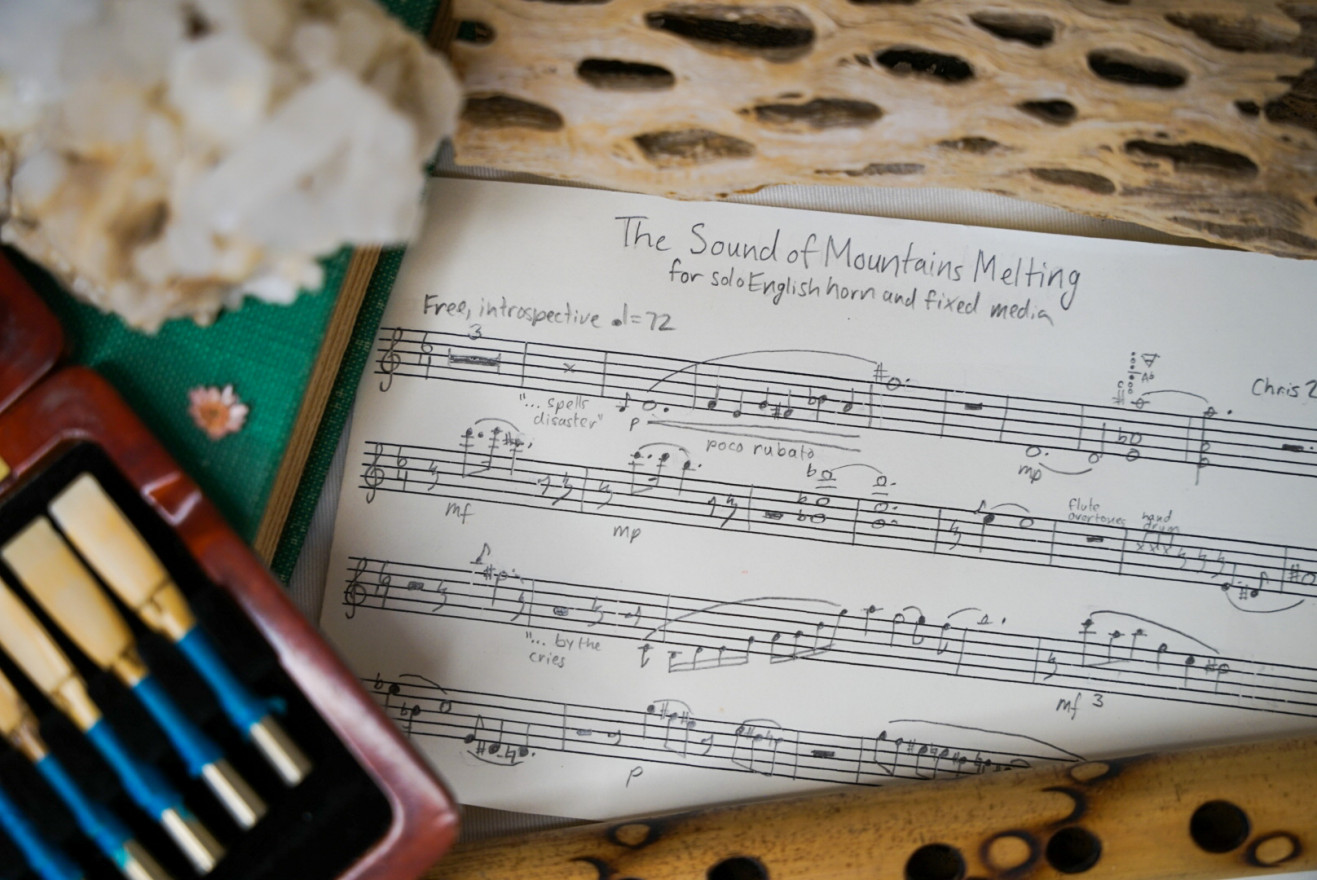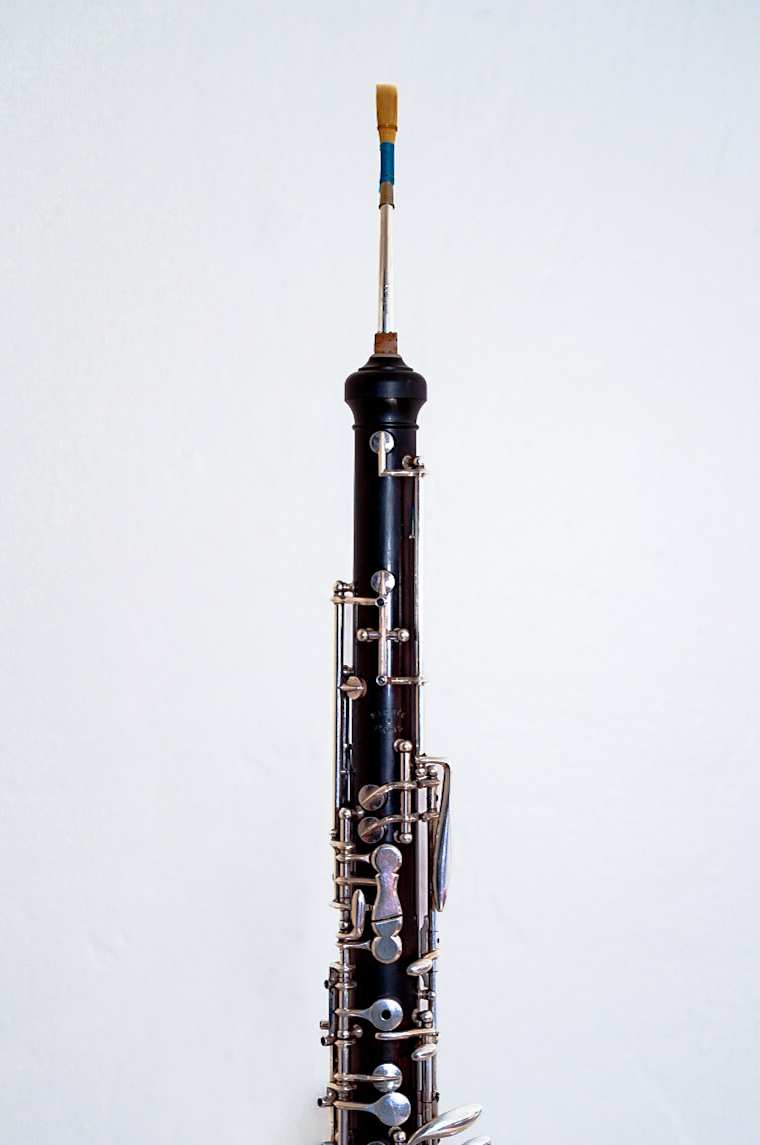
Handwritten sheet music inspired by Earth’s Wild Music by Kathleen Dean Moore, Ph.D. (Chris Zatarain)

Handwritten sheet music inspired by Earth’s Wild Music by Kathleen Dean Moore, Ph.D. (Chris Zatarain)
Musical recording and composition by Chris Zatarain
Music and sound have long been used to convey and express that which can not wholly be put into words. This can include the complex and difficult feelings that can arise especially in a world threatened by global climate change, with music serving as a vehicle to connect to one another through our varied and shared expriences, to heal, as well as to inspire action and change.
I composed this piece, The Sound of Mountains Melting, after reading the essay by the same name from the book Earth’s Wild Music by Kathleen Dean Moore, Ph.D. The piece is an electro-acoustic art music composition scored for solo English horn (a double-reed instrument in the oboe family) and fixed media, featuring field recordings from Glacier Bay, Alaska courtesy of Hank Lentfer, a close friend of Moore’s.
Inspired by the text, the piece uses the setting and elements of Moore’s story to serve as an introspective meditation on the inner turmoil that can come with the uncertainty of living in a time of anthropogenic climate change. In composing and performing the piece, I have poured my own experiences, thoughts, and feelings into the story.

In the essay, Moore describes an experience she had witnessing a glacier calving event in Alaska. To her, the experience is breathtaking, inciting an audible ‘awe’ as she watches massive blocks of ice crack and tumble from ancient glaciers. She even describes it as “possibly the most beautiful set of events [she has] ever seen.”
This feeling is juxtaposed, though, by the knowledge that thousands of miles away, real people are coming face to face with the very real consequences of a warming climate: catastrophic sea-level rise, severe flooding, ecosystem collapse, the consequent destruction of homes and property, and ultimately the loss of human life.
These feelings resonate with me personally, not because I have witnessed glaciers calving, but because I have felt subtler semblances of these feelings when I encounter an unseasonably warm winter day, or when I relish in an unusually wet monsoon season—the result of larger tropical storms ravaging the coasts of Mexico. Is it wrong to embrace the beauty of the natural world—to feel warmth and joy in experiencing her majesty despite the world seemingly drowning and burning down around us?
I don’t think that it is, but I don’t think knowing that makes it any easier either.
For those of us who have concern and love for our planet, it can be easy to succumb to fear, dread, and anxiety. I think it is important for us to grieve, but it is also incredibly important that we engage the beauty and the wonder of the world around us, so that we may have the strength to continue rising to defend it.
Here is a brief guide to the piece:
The piece begins with a mystical and uneasy feeling, as if to illustrate a sense of being a tiny human being on a little boat in a massive sea standing before frozen, primordial giants. Icy crotales shimmer and the narrator speaks “the beauty of the falling ice spells disaster,” introducing the dissonance between the here-coupled concepts of ‘beauty’ and ‘danger’. The English horn begins by ascending from the level of the boat, rising to greet the glaciers in an exalted cry.
The thunder and boom of the cracking and shifting ice, as well as the screeching of kittiwakes sound amongst low, evolving drones and hissing flutes. The melody winds and twists, reasoning and sighing, meant to evoke a sense of grappling with the two complexities, coming to one almost-conclusion and then to another. Multiphonics (a type of extended technique in which multiple pitches are played at once) are used to suggest a crunchy internal conflict and frustration.
The music at times is meant to feel turbulent, angry, confused, and even hurt. At its climax, the glacier, without warning, gives way in a large boom and gush. The music laments, sighing loudly as the ice fizzles out into the sea, followed by narration expressing the guilt and sadness that eclipses the experience, acknowledging a near-defeat by the the weight of climate change. The sound of the sea fades out and after a brief silence, a cry leaps out from the quiet. It serves as an alarm call, waking the spirit to rise back up and embrace the beauty of the world, saying firmly a resounding NO to succumbing to the sense of defeat.
The narrator gives a final quote, attributed to Hank Lentfer, reassuring that we must be present with the world and its beauty, that we must notice it and be glad for it. The piece ends with a sense of weary, but hopeful peace, fading off into the sea.
I offer this music as a gift to anyone struggling mentally, emotionally, or even spiritually during these difficult and uncertain times. My hope is that in some way this music might help you to lean deeper into your own feelings and maybe even to feel a little less alone in some of them.
I thank Kathleen Dean Moore for allowing me to work with her text in this way, as well as Hank Lentfer for generously supplying me with recordings from the field to bring the piece to life.